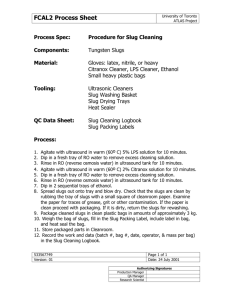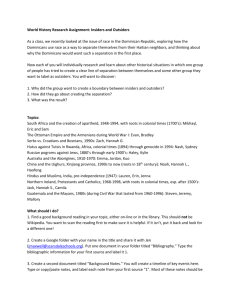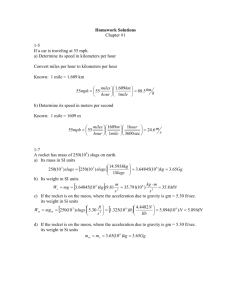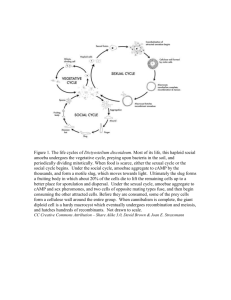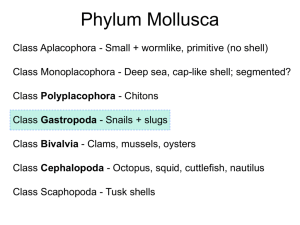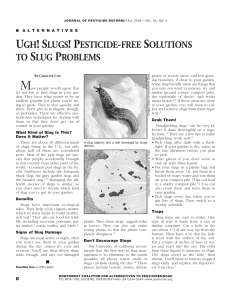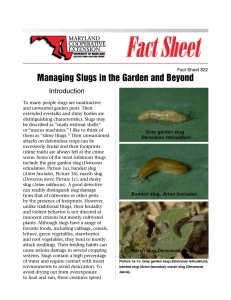us
advertisement
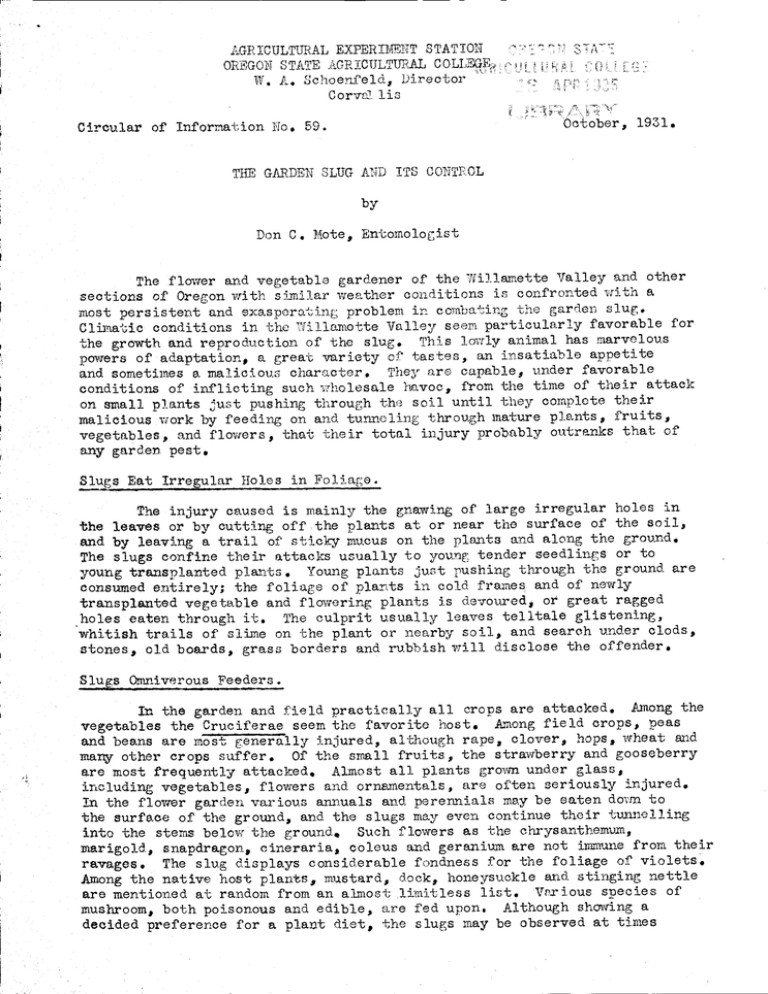
AGE ICULTURAL EXPERIMENT S TAT ION OREGON S TATE AGRICULTURAL COLLEGE Er. A. Schoenfeld, i)ireotor Corval us October, 1931. Circular of Information No. 59. THE GARDEN SLUG AND ITS CONTROL by Don C, Mote, Entomologist The flower and vegetable gardener of the Wilisnette Valley and other sections of Oregon with similar weather conditions is confronted with a most persistent and exasporating problem in combating the garden slug. Climatic conditions in the i1lamotte Valley seem particularly favorable for the growth and reproduction of the slug. This lowly animal has marvelous powers of adaptation, a great vuriety of tastes, an insatiable appetite and sometimes a malicious character. They are capable, under favorable conditions of inflicting such wholesale havoc, from the time of their attack on small plants just pushing through the soil until they complete their malicious work by feeding on and tunneling through mature plants, fruits, vegetables, and flowers, that their total injury probably outranks that of any garden pest. Slugs Eat Irregular Holes in Foliage. The injury caused is mainly the gnawing of large irregular holes in the leaves or by cutting off the plants at or near the surface of the soil, and by leaving a trail of sticky mucus on the plants and along the ground. The slugs confine their attacks usually to young tender seedlings or to young transplanted plants. Young plants just pushing through the ground are consumed entirely; the foliage of plants in cold frames and of newly transplanted vegetable and flowering plants is devoured, or great ragged holes eaten through it. The culprit usually leaves telltale glistening, whitiah trails of slime on the plant or nearby soil, and search under clods, stones, old boards, grass borders and rubbish will disclose the offender. Slugs niverous Feeders. In the garden and field practically all crops are attacked. Among the vegetables the Cruciferae seem the favorite host. Among field crops, peas and beans are most geneilly injured, although rape, clover, hops, wheat and marr other crops suffer. O the small fruits, the strawberry and gooseberry are most frequently attacked, Almost all plants gromn under glass, including vegetables, flowers and ornamentals, are often seriously injured. In the flower garden various annuals and perennials may be eaten doTm to the surface of the ground, and the slugs may even continue their tunnelling into the sterns below the ground. Such flowers as the chrysanthemum, marigold, snapdragon, cineraria, coleus and geranium are not immune from their ravages. The slug displays considerable fondness for the foliage of violets. Among the native host plants, mustard, dock, honeysuckle and stinging nettle are mentioned at random from an almost limitless list. Various species of mushroom, both poisonous and edible, are fed upon. Although showing a decided preference for a plant diet, the slugs may be observed at times devouring small life, such as ch.sabled earthworms, crippled mewhers of -their own species, sow'ougs, aphis, and lowly insects. Life Habits of Slugs Slugs belong to the phylum Molusca of the animal kingdom along with the snails, clams and oysters. The three species of slugs of economic importance in Oregon in order of frequency of occurrence are: the gray garden slug (Agriolimax agrostis); the greenhouse slug Milax gagates); saon andersoni). and the roticrated slug - They have soft bodies covered with a sensitve, moist skin provided with numerous minute glands from which they expeL a mucus slime. This material is produced in abundance when they are disturbed, and is exuded on ohjec;s over which the slugs crawl, remaining as a dried, mucus trail behind them. They aze typically nocturnal in habit and by far the majority of their activities are carried forward at night. During the day they normally conceal themselves in dark moist places in basements, under boards, rocks crevices in the soil, During our protracted and trash, and in tunnels periods of dark, cloudy, moist weather, however, the slugs remain active throughout the day, and during periods of protracted precipitation become unusually abundant in slightly elevated areas, such as walks. The information at hand regarding the detailed life history of the It is not kn.ovm definitely just how long a slug may slug is rather n:teager. live, but the estimated span of life ranges from 18 months to 2 years. The period of development from egg to a mature slug will vary urith the seasos d quantity of food hut is probably from 90 days to 1 year. The nuu1:er of slug eggs laid by one female is estimated. from 600 to 600. Thus the gardc is very prolific. Eggs are produced at about every season of the year, though reduced in numbers during August when the season is exceptionally dry and during the more extreme portions of the winter. They mate often and egg laying is frequent and abundant. Control Measures. In planning the control campaign against the garden slug., ii is usually not advisable to rely upon any single control measure alone. The sluzs are not easy to combat end a combination of two or more methods of fighting them is usually necessary f or effective results. 1. One of the most important measures in combating slugs is cleanliness about the yard and garden. Destroy, burn or clean fence rows, waste areas and uncultivated tracts adjacent to cultivated fields. Remove all crop remnants as early in the fall as at all practoah1e; practice fall cultivation, where feasible, Clean up all trash, brush, burlap, hoards and unsightly - material ahent the house, yard, outbuildings and garden. It is a good practice on general principles and it destroys a slug paradise. 3. 2, The collection and destruction of the slugs end their eggs is of If only a few hiding places, these may be v1s.ted during the value. lay and the slugs, and. sometimes their eggs that are found there, can be destroyed. Many slugs can be found feeding on the plants at night by the aid of a flashlights a persistent search for them at night will often be well rewarded. Poultry, including duok, geese, chickens and bantam chickens feed on slugs. Ducks and geese seem especially fond of them, devouring great numbers where allowed access to infested areas. In tests conducted by the Oregon Experiment Station, a combination of a repellent and a poison bait gave good results. The repellent used was bordeaux mixture sprayed on the foliage of the plants. Slugs apparently eat foliage sprayed with bordeaux only under stress from lack of other food, The bordeaux mixture may be made or purchased from your dealer in spray materials. The at ho forirn.üa for a small amount of bordeaux mixture is as follows: Copper sulfate Quicklime Water 1 pound 1 pound 12 1/2 gallons Use only wooden or earthenware vessels in preparing bordeaux. Dissolve the copper sulfate in 2 gallons of water in one vessel. Slake the lime end make up 2 gallons in another vessel. Pour the rc solutions simultaneously through a strainer into a container Should you not care to bother holding 8 i/z gallons of water, with mixing up the bordeaux at home, it can be purchased from your dealer in insecticides already prepared as a powder. 5, A poison bait for use in combination with the bordeaux spray consists of calcium arsenate 1 ounce; chopped lettuce leaves 1 pound. Mix well and scatter in small protected heaps about the area to be safeguarded. In case lettuce is not available, tender foliage of cabbage, clover or other succulent boyce may be used. Raw diced carrots or potatoes covered with calcium arsenate have been 01' nearly equal value is the poison bran mash as reeQramended. recoimnended for outworms. Care must be exercised in using these poison baits. Poultry, birds and even children may be poisoned f the baits are scattered promiscuously and carelessly around the premises in large heaps. As an extra precaution it has been suggested that the bait be placed in small piles upon pieces of shingles, boards or tin and. covered carefully with a box or large board. There is still another and important reason 1' or this precaution - many tender plants apparently are very sensitive to the presence of arsenic in the soil. Collect and destroy, by bui.ng or burning, all bait that is not consumed, These precautions not only protect the birds and tender plants, but the slugs are me apt to find the bait, as they crawl under the box or board for protection during the day. 6. Lime, soot, ashes, salt, pewdered copper sulfate and J4me, copper carbonate or dry bordeaux mixture periodically dusted on the soil about the p1cm-b and also lightly hoed. in between the rows givos temporary protection. Care should be exercised in application as some f these substances may burn the plant.
